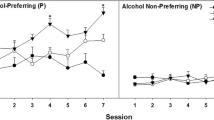Abstract
Voluntary consumption of alcohol by rats (i.e. in the absence of food or water deprivation, sweetening of the alcohol solution, etc.) that results in the attainment of behaviorally significant or pharmacologically detectable blood alcohol levels (BALs) has been difficult to demonstrate. In this study, we showed that free-feeding Wistar rats given access to increasingly concentrated solutions of alcohol in separate “drinking” cages on a 1-h per day basis drank on average close to 1 g/kg, resulting in average BALs close to 50 mg%. This drinking was comparable to that obtained by rats trained according to a procedure used widely by others in which animals are maintained at reduced body weights. Weight restriction alone, however, did not enhance amount of alcohol consumption over that of free-feeding animals in the 1-h session. There was also a strain difference in that Wistar rats drank significantly more than did Sprague-Dawley rats. Post hoc absorption curves showed that the initial absorption of alcohol from both the stomach and the peritoneum was slower in Wistar than in Sprague-Dawley rats, suggesting rate of absorption may be inversely related to amount of alcohol consumed; metabolic rates and volumes of distribution appeared unrelated to consumption. This periodic availability paradigm might be useful to investigate the effect of biological variables on individual bouts of alcohol consumption.
Similar content being viewed by others
References
Belenko S, Woods SC (1973) Physiological correlates of ethanol self-selection by rats. Physiol Psychol 1:155–157
Brewster DJ (1969) Ethanol preference in strains of rats selectively bred for behavioral characteristics. J Genet Psychol 115:217–227
Curi R, Hell NS, Bazotte RB, Timo-Iaria C (1984) Metabolic performance of free fed rats subjected to prolonged fast as compared to the metabolic pattern in rats under long-term food restriction. Physiol Behav 33:525–531
Eckhardt MJ (1975) The role of orosensory stimuli from ethanol and blood-alcohol levels in producing conditioned taste aversion in the rat. Psychopharmacologia 44:267–271
Erickson CK, Kochhar A (1985) An animal model for low dose ethanol-induced locomotor stimulation: Behavioral characteristics. Alcoholism: Clin Exp Res 9:310–314
Grant KA, Samson HH (1985) Induction and maintenance of ethanol self-administration without food deprivation in the rat. Psychopharmacology 86:475–479
Grupp LA, Perlanski E (1979) Ethanol-induced changes in the spontaneous activity of single units in the hippocampus of the awake rat: A dose-response study. Neuropharmacology 18:63–70
Grupp LA, Perlanski E, Stewart RB (1986) Diet and diuretics in the reduction of voluntary alcohol drinking in rats. Alcohol and Alcoholism 21:75–79
Haggard HW, Greenberg LA, Lolli G (1941) The absorption of alcohol with special reference to its influence on the concentration of alcohol appearing in the blood. Q J Stud Alcohol 1:684–726
Holloway FA, Bird DC, Davenport JA (1984) Periodic availability: Factors affecting alcohol selection in rats. Alcohol 1:19–25
Kulkosky PJ (1980) Blood ethanol and free-choice ethanol intake in rats and their progeny. Pharmacol Biochem Behav 13:449–452
Lester D, Freed EX (1973) Criteria for an animal model of alcoholism. Pharmacol Biochem Behav 1:103–107
Li TK, Lumeng L (1984) Alcohol preference and voluntary alcohol intakes of inbred rat strains and the National Institutes of Health heterogeneous stock of rats. Alc Clin Exp Res 8:485–486
MacDonnell JS, Marcucella H (1979) Increasing the rate of ethanol consumption in food- and water-satiated rats. Pharmacol Biochem Behav 10:211–216
Meisch RA (1976) The function of schedule-induced polydipsia in establishing ethanol as a positive reinforcer. Pharmacol Rev 27:465–473
Meisch RA (1984) Alcohol self-administration by experimental animals. In: Smart RG, Glaser FB, Israel Y, Cappell H, Kalant H, Schmidt W, Sellers EM (eds) Research advances in alcohol and drug problems, vol. 8. Plenum, New York, pp 23–45
Melchior CL, Myers RD (1976) Genetic differences in ethanol drinking of the rat following injection of 6-OHDA, 5,6-DHT or 5,7-DHT into the cerebral ventricles. Pharmacol Biochem Behav 5:63–72
Mello NK (1973) A review of methods to induce alcohol addiction in animals. Pharmacol Biochem Behav 1:89–101
Mirsky IA, Piker P, Rosenbaum M, Lederer H (1941) “Adaptation” of the central nervous system to varying concentrations of alcohol in the blood. Q J Stud Alcohol 2:36–45
Reid LD, Hunter GA, Beaman CM, Hubbell CL (1985) Toward understanding ethanol's capacity to be reinforcing: a conditioned place preference following injections of ethanol. Pharmacol Biochem Behav 22:483–487
Satinder KD (1972) Behavior-genetic-dependent self-selection of alcohol in rats. J Comp Physiol Psychol 80:422–434
Shippenberg TS, Altschuler HL (1984) Strain-related differences in the excitatory effects of ethanol. Role of mu and delta opiate receptors. Soc Neurosci Abstr 10:569
Stewart RB, Grupp LA (1984) A simplified procedure for producing ethanol self-selection in rats. Pharmacol Biochem Behav 21:255–258
Stiglick A, Woodworth I (1984) Increase in ethanol consumption in rats due to caloric deficit. Alcohol 1:413–415
Wise RA (1973) Maximization of ethanol intake in the rat. In: Gross MN (ed) Alcohol intoxication and withdrawal, vol. 2. New York, Plenum, pp 279–294
York JL (1978) A comparison of the discriminative stimulus effects of ethanol, barbital, and phenobarbital in rats. Psychopharmacology 60:19–23
Author information
Authors and Affiliations
Rights and permissions
About this article
Cite this article
Linseman, M.A. Alcohol consumption in free-feeding rats: procedural, genetic and pharmacokinetic factors. Psychopharmacology 92, 254–261 (1987). https://doi.org/10.1007/BF00177925
Received:
Revised:
Issue Date:
DOI: https://doi.org/10.1007/BF00177925




